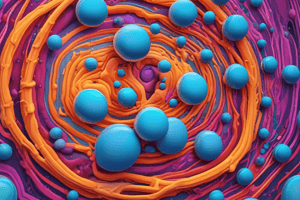Podcast
Questions and Answers
What is the primary component of the plasma membrane's lipid bilayer?
What is the primary component of the plasma membrane's lipid bilayer?
- Glycolipids
- Proteins
- Cholesterol
- Phospholipids (correct)
Which type of transport does not require energy input according to the text?
Which type of transport does not require energy input according to the text?
- Facilitated diffusion
- Active transport
- Endocytosis
- Passive transport (correct)
What do transport proteins do in relation to the plasma membrane?
What do transport proteins do in relation to the plasma membrane?
- Prevent substances from passing through
- Facilitate movement of substances across the membrane (correct)
- Produce energy for cellular processes
- Form the lipid bilayer
Which of the following is NOT a type of passive transport mentioned in the text?
Which of the following is NOT a type of passive transport mentioned in the text?
What is another term for facilitated diffusion as mentioned in the text?
What is another term for facilitated diffusion as mentioned in the text?
Which component of the plasma membrane helps in regulating the movement of substances in and out of cells?
Which component of the plasma membrane helps in regulating the movement of substances in and out of cells?
What is the main source of energy required for active transport?
What is the main source of energy required for active transport?
Which transport mechanism moves substances against their concentration gradient?
Which transport mechanism moves substances against their concentration gradient?
What type of proteins form hydrophilic pores for passive movement of ions and small molecules?
What type of proteins form hydrophilic pores for passive movement of ions and small molecules?
Which of the following statements about diffusion is correct?
Which of the following statements about diffusion is correct?
What do carrier proteins do in the process of passive transport?
What do carrier proteins do in the process of passive transport?
Which type of active transport mechanism uses the energy stored in the concentration gradient of another substance?
Which type of active transport mechanism uses the energy stored in the concentration gradient of another substance?
Study Notes
Homeostasis and the Plasma Membrane: A Focus on Structure, Transport, and Regulation
At the heart of homeostasis, the process by which our bodies maintain a stable internal environment, lies the plasma membrane of our cells. This dynamic, selective barrier not only protects cells but also enables them to interact with their environment by regulating the movement of substances in and out. Let's dive into the structure of the plasma membrane and the various transport mechanisms that ensure homeostasis is achieved.
The Plasma Membrane: Structure and Function
The plasma membrane is composed of a lipid bilayer, primarily made up of phospholipids, cholesterol, and glycolipids. This bilayer serves as a semi-permeable barrier, allowing some substances to pass through while preventing others from doing so. The plasma membrane also features proteins embedded within it, some of which are involved in transport processes.
Transport Proteins
Transport proteins are membrane proteins that facilitate the movement of substances across the plasma membrane. They can be categorized into two main groups:
-
Passive Transport: Passive transport, also known as facilitated diffusion, does not require energy input. Substances move down their concentration gradient, from an area of high concentration to an area of low concentration. This transport method includes carrier proteins, channel proteins, and porins.
-
Active Transport: Active transport requires energy in the form of ATP (adenosine triphosphate). This method moves substances against their concentration gradient. The transport proteins involved include pumps and secondary active transporters.
Diffusion
Diffusion is a passive transport mechanism that allows substances to move from an area of high concentration to an area of low concentration. The rate of diffusion depends on the concentration gradient and the size, shape, and polarity of the substance.
Passive Transport Mechanisms
-
Carrier Proteins: Carrier proteins bind to specific molecules and temporarily change shape, allowing the substances to move across the membrane. Once the substance is released on the opposite side, the carrier protein returns to its original shape.
-
Channel Proteins: Channel proteins form hydrophilic pores through which specific ions and small molecules can passively move across the membrane.
-
Porins: Porins are protein channels that allow the passive movement of water and small polar molecules through the plasma membrane.
Active Transport Mechanisms
-
Pumps: Pumps use ATP to actively move substances against their concentration gradient. They include sodium-potassium pumps, calcium pumps, and proton pumps.
-
Secondary Active Transporters: Secondary active transporters use the energy stored in the concentration gradient of another substance to move substances against their concentration gradient. They include symporters and antiporters.
The plasma membrane and its transport proteins play a critical role in maintaining homeostasis. This dynamic barrier enables cells to selectively import and export substances, ensuring that the body's internal environment remains stable and functioning optimally. Understanding these processes at the cellular level is a cornerstone of biology and provides essential insights into the maintenance of health and the progression of diseases.
Studying That Suits You
Use AI to generate personalized quizzes and flashcards to suit your learning preferences.
Description
Test your knowledge on the structure of the plasma membrane and the transport mechanisms that contribute to maintaining homeostasis. Explore topics such as passive transport, active transport, diffusion, carrier proteins, channel proteins, pumps, and more.




